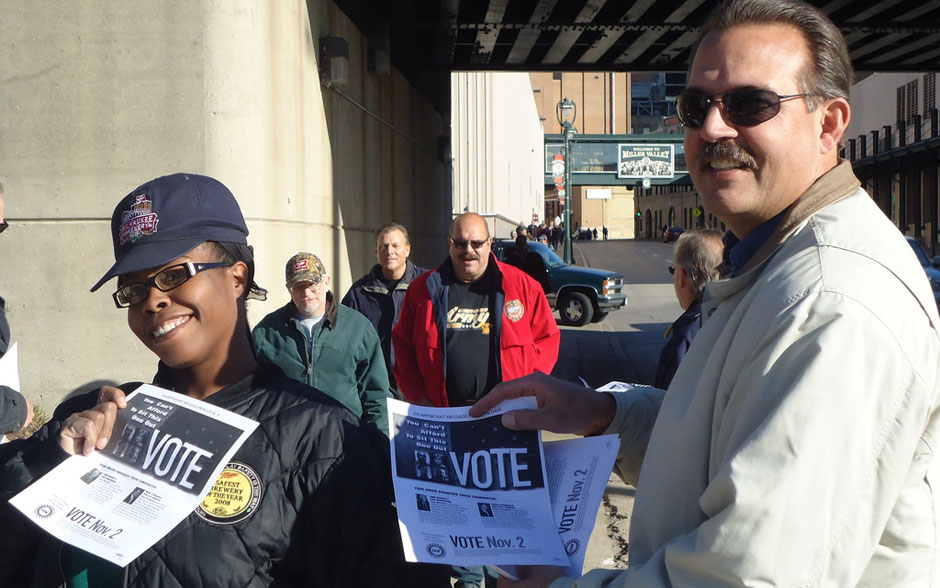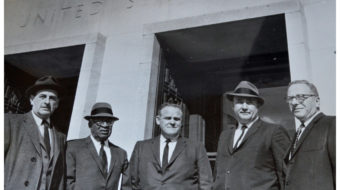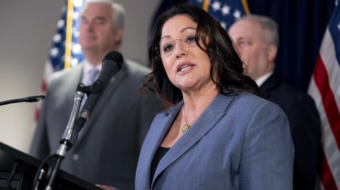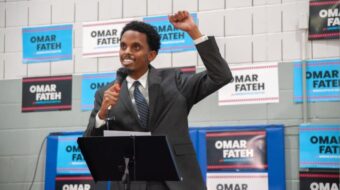
WASHINGTON (PAI)—The AFL-CIO has started distributing 1.3 million leaflets in key Senate and gubernatorial races in 15 battleground states, one of a burgeoning set of union political initiatives as the November election approaches.
In some cases, the Fed is backing the same hopefuls progressives supported. In others, it isn’t. And in some cases, individual unions—such as the Communications Workers and National Nurses United, who banded together for Ben Jealous in Maryland—backed more progressive nominees in the primaries and still back them in the general election.
The leaflet drop is just one facet of unions’ increased political campaigning as the November election approaches. Others include individual unions’ TV ad buys in key races, phone banking, and precinct walks.
Two gubernatorial progressives the Fed’s supporting though are, like Jealous, African-American Democrats: State legislator Stacey Abrams in Georgia and Tallahassee Mayor Andrew Gillum in Florida. Both races are toss-ups.
So are most of the other races where the fed is leafleting.
Leaflets went out backing Democratic hopefuls in Arizona (governor and Senator), Colorado (governor), Florida (Gillum and Sen. Bill Nelson), Abrams in Georgia, and businessman Fred Hubbell in Iowa. Kathy Glasson, head of the state Service Employees, finished second to Glasson in the primary. The state fed did not back her then.
The Fed also sent out leaflets for gubernatorial nominees in Maine, Michigan (Kathy Whitmer), Minnesota (Rep. Tim Walz, a union member, and appointed Sen. Tina Smith (D)—who seeks to fill an unexpired term), Nevada, Ohio (Kevin Cordray), and Wisconsin.
There, state superintendent of public instruction Tony Evers is making labor’s third try to knock off extreme right-wing GOP Gov. Scott Walker, whose notorious anti-union Act 10 emasculated public worker unions in the Badger State. That race, too, is a toss-up.
Other Senate nominees who get favorable leaflets include incumbents Claire McCaskill in Missouri, Joe Donnelly in Indiana, Jon Tester in Montana, and Tammy Baldwin in Wisconsin. Trump carried Indiana, Montana, and Missouri handily in 2016 and Wisconsin narrowly—after a GOP voter ID law shoved thousands of African-Americans off the rolls in Milwaukee.
The distribution of 1.3 million leaflets outlining pro-worker stands of selected candidates is just one of many facets of both the fed’s and individual unions’ campaigns in the homestretch towards November 8. Others include:
- The Mine Workers will start running TV spots in mid-October in an independent expenditure campaign to help re-elect Democratic Sen. Joe Manchin in West Virginia, which President Donald Trump carried by an enormous margin over Democratic nominee Hillary Clinton, whom UMWA did not endorse. Manchin, who voted in favor of confirming Trump’s Supreme Court nominee Brett Kavanaugh, was not on the fed’s leaflet list.
Miners union President Cecil Roberts, however, said Manchin led congressional efforts to keep health care benefits for 22,600 retired miners, their dependents, and widows in 2017. “That was a fight few thought we could win, but we did because we wouldn’t quit and neither would Joe Manchin,” Roberts said. “He knows how to get things done in Washington, and West Virginia needs that.”
- Traditional get-out-the-vote methods, such as precinct walking and phone-banking. That’s what’s going on in the Twin Cities, for example as unions strive to elect Walz (D), a union member (Education Minnesota) as governor and put appointed Sen. Smith (D), formerly lieutenant governor, into the last two years of Al Franken’s unexpired term. Both are on the national AFL-CIO’s leafleting list. Incumbent Sen. Amy Klobuchar (D), considered safe, is not.
“The next few weeks are going to make or break the election,” David Gilbert-Pederson, organizer for the Minneapolis Regional Labor Federation, told a crowd on September 4 as the local fed opened its Labor 2018 campaign office, the Minneapolis Labor Review reported.
“I believe in the future of our pension, the future of our union. I feel Walz can deliver that,” Fire Fighters Local 82 member Teddy Jacobsen of Ham Lake told the paper. It’s his first door-knocking in years.
“Your vote makes a difference,” added Minneapolis fed President Chelsie Glaubitz Gabiou. “312 votes. 8,770 votes. 2 votes. That’s how many votes labor-endorsed candidate Al Franken won his 2008 U.S. Senate election by, how many votes labor-endorsed candidate Mark Dayton won his 2010 gubernatorial election by, and how many votes labor-endorsed candidate Dwayne Lowman won his 2013 Bloomington city council election by, respectively.”
“Yes, every vote makes a difference,” Gabiou added. So does member-to-member political organizing, which is part of the walks and phone-a-thons. The Republican nominee against Walz has pledged, with the help of a GOP-majority legislature—-and that, too is up for grabs-—to make Minnesota like Walker’s Wisconsin, which is right next door, this November.
- Specific issues, and especially under-funded schools, from earlier this year are carrying over into political activism this fall. In the four states which saw teachers strike over deteriorating conditions, lousy pay, and other GOP-inspired anti-teacher moves, teachers have turned out in droves.
In Oklahoma’s primaries, six teachers unseated anti-teacher state lawmakers who voted against pay raises and improving the schools. In Arizona, Democratic gubernatorial nominee David Garcia benefits from the continuing teacher activism which forced the GOP-run legislature to fund a pay hike and fix deteriorating school buildings. His foe, incumbent GOP Gov. Doug Ducey, reluctantly signed the legislation—and only after a statewide walkout and massive community support for the teachers.
“With your help, he can be Arizona’s first Latino governor in four decades,” one progressive group says. The fed’s leafleting includes Garcia and U.S. Rep. Kristen Sinema (D), who’s seeking an open U.S. Senate seat.
But while the Fed puts money and people into toss-up tilts, it is apparently shying away from some races which progressive candidates won, including one uphill battle in Maryland.
It’s also bypassing pro-worker and/or progressive officials it expects to handily win. They include California Lieut. Gov. Gavin Newsom, seeking the open governorship, New York Gov. Andrew Cuomo, Ohio Sen. Sherrod Brown, and Pennsylvania Gov. Tom Wolf. All have substantial leads and all but Brown—along with Cordray—are running in deep-blue states.
Shunned progressive hopefuls include Alexandria Ocasio-Cortez, a Democratic Socialist headed toward a U.S. House seat from the Bronx, and Jealous, the progressive former head of the NAACP, who won Maryland’s Democratic gubernatorial primary.
Both are former Bernie Sanders supporters in the 2016 Democratic presidential primary campaign against Clinton, the Democratic establishment and AFL-CIO favorite. Ocasio-Cortez is expected to win in a walk—so much so that she’s campaigning elsewhere nationwide. The Fed did not return an e-mail asking why it is not leafleting for Jealous.










